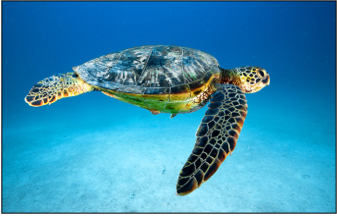SYLLABUS
GS-2: Conservation, Environmental Pollution and Degradation, Environmental Impact
Context: Recently, the International Union for Conservation of Nature (IUCN) has reclassified the green sea turtle from “Endangered” to “Least Concern” due to sustained global conservation efforts.
More on the News
• The IUCN’s latest Red List update at the World Conservation Congress in Abu Dhabi reported a 28% rise in green sea turtle population since the 1970s, marking a major conservation success.
• This recovery is attributed to decades-long conservation efforts that include protection of nesting beaches, reduction in turtle bycatch through Turtle Excluder Devices, and community-led awareness programs.
• Successful initiatives in regions such as Ascension Island, Brazil, Mexico, and Hawaii have helped restore some turtle subpopulations to near pre-commercial exploitation levels.
• Despite global improvements, the population remains below historical levels, and several subpopulations, particularly in the Southwest Pacific, continue to show declining hatchling success.
• The IUCN Red List now documents over 172,000 species, of which more than 48,000 remain threatened with extinction, showing that while progress has been made, challenges persist globally
About the Green Sea Turtle (Chelonia mydas)
• The green sea turtle is a large marine reptile found in tropical and subtropical waters worldwide, with significant populations in the Atlantic, Pacific, and Indian Oceans.
• They are often seen in the Caribbean, around the Hawaiian Islands, and in the Great Barrier Reef.
• The species is named for the greenish color of its body fat, which comes from its herbivorous diet of seagrass and algae.
• It is one of the largest sea turtle species, with adults weighing between 100–180 kilograms and reaching lengths of up to 1.5 meters.

• The species spends most of its life in shallow coastal waters, bays, and estuaries but migrates long distances between feeding grounds and nesting beaches.
• The species plays a vital ecological role as a keystone species in tropical marine ecosystems, supporting coral reef and seagrass health.
• Major nesting sites include the Caribbean, Australia’s Raine Island, Mexico, and parts of the Indian Ocean such as Seychelles and Sri Lanka.
• Climate change poses a significant risk to the species, as rising sand temperatures can affect hatchling sex ratios and increase nest mortality.
About IUCN
Created in 1948, IUCN is now the world’s largest and most diverse environmental network, harnessing the knowledge, resources and reach of our more than 1,400 Member organisations and 17,000 experts. This diversity and expertise makes IUCN the global authority on the status of the natural world and the measures needed to safeguard it.
Way Forward
• Conservation measures such as beach patrolling, community engagement, and turtle-safe fishing technologies continue to play a key role in sustaining their recovery.
• The global rebound of the green sea turtle stands as a model example of how international cooperation and local conservation can restore long-lived marine species.
UPSC Mains Practice Question
The recent recovery of the green sea turtle population, as highlighted by the IUCN, demonstrates how coordinated global conservation can reverse biodiversity decline. Discuss the key conservation strategies that contributed to this success and the challenges that continue to threaten marine biodiversity worldwide.

